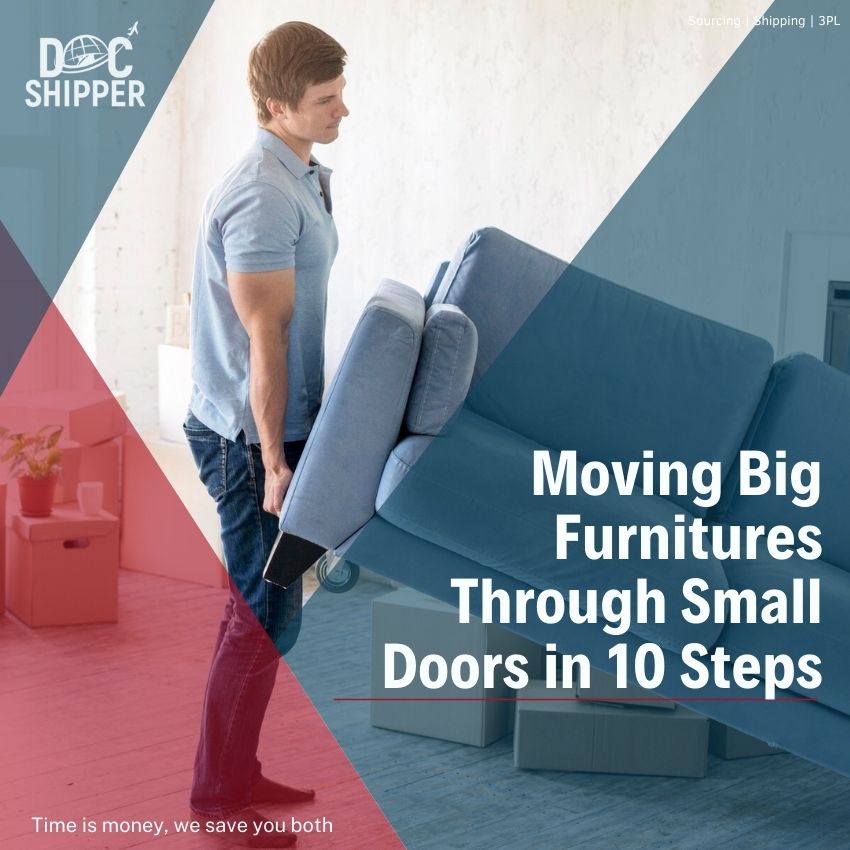After weeks of preparation and intense DIY days, D-Day moved. Everything goes as planned until you realize that your sofa is too wide to enter your living room. It does not pass through the doorway, whose width you have overestimated.
Moving: How to bring a large piece of furniture through a small door?
No panic, everything is not lost yet. Have you tried to get the door out of its hinges? You will gain a few centimeters that can prove very precious. Is your sofa disassembling? Sometimes the feet are retractable. Have you thought of making it go through the window? You could hoist it with ropes along the outside wall. This will require a bit of energy and a few cold sweats, but if you do it well, it should be fine.
If your sofa has a lot of value, you could ask a carpenter or upholsterer to disassemble it, then reassemble it once the door is passed.
If you do not have the soul of a handyman, it is better to contact an international moving expert. He may have a solution to offer you.
The last solution, mourn his sofa … Is not this finally the opportunity to get rid of it? You’ve been thinking about it for several years. It may cost you a little (a lot) of money but do you really have a choice? To finance the purchase of the new sofa, post an ad on a classifieds site, you may get a good surprise.
10 steps to get your bulky supplies through a small door
Step 1: Take the exact measurements of your furniture first
When moving large pieces of furniture from your current home or into a new home, it’s helpful to do your homework ahead of time so that you’re better prepared if you get caught in the middle. The old adage “prevention is the best cure” is truer than ever when it comes to moving large furniture.
The first step to solving the problem of furniture not getting through the door is to avoid it in the first place. How? Simply measure the dimensions of the furniture, then measure the entryway or hallway, and compare the results to decide on next steps.
The procedure shown here is an example of measuring a large sofa, but it can be used for other types of large furniture as well. So take out your tape measure and measure your furniture as follows:
A certain height (H). To calculate the precise height, measure the distance from the floor to the highest point of the sofa, which is usually the backrest.
Diagonal height (DH). Measure the distance from the front corner of an armrest to the opposite back corner of the sofa. You will be able to detect if your furniture can fit in a small space when standing if you know its diagonal depth.
Dimensions (W). Calculate the distance between the two widest points of the sofa.
Field of view (D). Measure the distance between the two deepest points of the sofa, one in the front and one in the back.
Diagonal Depth (DD). Measure the distance from the top left (or top right) corner of the armrest to the opposite bottom corner of the object.
Write down the measurements of your large furniture pieces so you don’t forget.
Step 2: Measure the width of your doors
The second step in making sure your massive furniture fits through seemingly smaller doorways and hallways is to measure the openings through which the massive furniture will have to pass on the way to the moving truck (if moving) or into the final destination room (if moving).
This is not difficult; simply measure the height and width of each door, hallway, elevator or stairwell along the desired route. Keep the rails in mind when designing your approach to transferring large pieces of furniture down or up the stairs.
It’s a good idea to compare the size of the holes to the size of the large items you’re transporting. In general, a quick look at the measurements should give you an idea of whether you’re likely to run into problems and, if so, how big those problems will be.
Remember, numbers never lie.
Step 3: Analyze Your Options
Take the time to analyze your options and choose the best course of action to prepare for moving your large furniture items out of your current home or into your new home.
In either case, don’t make a hasty decision, because if you get stuck in a doorway with a huge, bulky piece of furniture, you’ll waste ten times as much time. What about the neurological consequences of the traumatic event?
In addition, a comparison of the measures described above should result in the following three scenarios:
- Scenario 1: Your furniture will easily fit through all openings. This is good news.
- Scenario 2: Your furniture is a little higher (by a few centimeters) than the measured doorways and hallways. That’s okay, because there are ways to get your tall furniture safely through the openings (read on to learn more).
- Scenario 3: Your furniture is much larger than the doors and hallways along the recommended evacuation route. However, as you’ll learn later about the different methods of getting furniture through a doorway, this shouldn’t be a big problem. Overall, it’s reassuring to know that even if all your DIY projects fail, you still have a foolproof solution to your furniture problem – for more details, see Step 10.
Step 4: Recruit enough people
When the time comes to move the heavy and bulky furniture in your home, this step will ensure that you are not entirely alone. You have clearly made the wise decision not to hire professional movers.
You’ve clearly made the wise decision not to hire professional movers, which means you’ll be much smaller on moving day.
You will need at least two extra people to move your huge pieces of furniture out of your house or apartment without causing property damage or bodily harm. If possible, enlist the help of more than two friends (the more the better), but the minimum of three people is a safety requirement.
It will take a lot of people to get your large couch through a tiny door or your huge dresser down a narrow hallway to the moving truck. Let your friends know as soon as possible so they can book that day and time for you.
Remember, if you can’t find at least two people to help you with this furniture problem, you should cancel the idea and call professional movers instead.
Step 5: Dismantle any large furniture
If the measurements showed bad news (Scenario 2 or Scenario 3 in Step 3), it’s time to use your creativity to fix the furniture fitting problem by completing the steps below.
This step is self-evident: disassemble your colossal furniture such that the removed components reduce the overall size of the basic frame. If there is a safe way to break down a big piece of furniture into smaller pieces, use it.
Legs, arms, doors, panels, decorations, and other protruding elements that may be removed safely should be removed. Furniture legs are the most bothersome in the majority of circumstances, so make sure you remove them by unscrewing or pulling them out. Essentially, you want to minimize the size of the huge piece of furniture to the bare minimum required for structural integrity.
Separate the dismantled furniture components with bubble wrap or thick furniture covers for further protection.
Step 6: Play with different angles
What if your furniture doesn’t fit through the door? Improvise.
Simply put, you should know what to do if you’re stuck in a door with a large piece of furniture, since you’re there and can see both the problem and the solution.
Remember, there is a reasonable solution; you just have to find it. After all, that huge piece of furniture was moved into the room safely the first time. Wasn’t it?
When you’re in a tight spot, this step is all about improvisation. Just consider the best starting angles of the furniture in relation to the small hole.
The first thing to do is carefully maneuver around the door frame until you discover the precise angle that will allow you to get through without injury. When maneuvering large pieces of furniture through narrow doorways, keep in mind that changing the starting angles can have a significant impact. All your movements should be gradual and deliberate.
The second option is to gently rotate the couch or other furniture in the entryway while standing at its end. As long as you have the right angle, slow and precise movements should be enough to get your furniture into the entryway or hallway.
Step 7: Try to fit it through the space
Some of your larger furniture pieces may need a few extra inches to fit safely through doorways and hallways. What if your sofa, for example, doesn’t fit through the door? The solution may surprise you: just squeeze it through.
Sofas and couches have soft edges that can be crushed without damage, allowing them to fit through a narrow entrance. In this case, it’s all about getting those extra inches of space through the upholstered furniture areas.
However, before using this simple method, there are a few precautions to take to keep things from getting out of hand:
Protect your fingers by using quality work gloves and being careful where you place your hands when moving furniture; wrap furniture in cling film so it doesn’t get dirty from rubbing against the door frame.
Step 8: Open the door (temporarily)
You may end up with a huge couch, desk, dresser, table, or other bulky household item, even if you follow the guidelines above to fit a large couch, desk, dresser, table, or other bulky household item through a door. When you just need a little extra room to look at something, where do you look for that extra inch or two?
When trying to fit heavy furniture through narrow doorways and hallways, an uncommon solution is to temporarily remove the door. This solution isn’t always possible, but when it is, it’s worth a try.
Discuss this option with your colleagues to determine if you are up to the task. Make sure you understand what you are doing so you don’t end up with a bigger problem than you already have.
With the help of a friend, lift the door in question off its hinges and place it out of the way. Remember to do this slowly and carefully.
Step 9: Remove the door jamb
If the last step didn’t work, there’s one more thing you can do to get a little more space maybe an inch or two. That’s right, we’re talking about removing the door frame at this point if that’s possible.
It may seem frantic to remove the door frame after you’ve already removed the door, and that’s true. However, in extreme situations, desperate measures must be used, and this last step may just save you from the dreaded moving day.
This step will only work if the door frame is made of wood and is secured with small, visible nails that are accessible and easy to remove with the right tool. You will need to adjust the door frame after pushing the giant piece of furniture in or out if you decide to go that far to fit large furniture through the door.
Step 10: Hire movers to help you
Hire the services of a professional mover. Things don’t always work out the way you want them to, no matter how hard you try. While acknowledging a loss is painful, it is often essential to avoid future problems.
If none of the above steps have been effective, it is time to seek professional help. Finally, knowing when to give up is crucial, as excessive persistence can lead to property damage and even physical injury.
Do you further information ?
Download our brochure (PDF) !
FAQ | Moving big furnitures through small door
Read more
Looking for more? These articles might interest you:
DocShipper info: Do you like our article today? For your business interest, you may like the following useful articles :
Need Help Shipping
Personal Items ?
First, we handle the packing, transport, and customs clearance of your personal belongings with care and precision. Then, we ensure a smooth door-to-door relocation experience — from pickup to final delivery — making sure your items arrive safely, on time, and at highly competitive prices.


Fill the Form
Prefer email? Send us your inquiry, and we’ll get back to you as soon as possible.
Contact us




